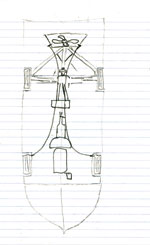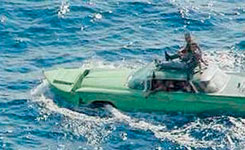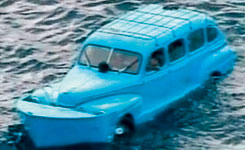 Turning
an ancient Chevy truck into an oceangoing vessel is actually rather
straightforward. Working in a makeshift shop at Basanta’s house, the
two men sealed the bottom of the truck into a relatively flat hull
with welded sheetmetal. Turning
an ancient Chevy truck into an oceangoing vessel is actually rather
straightforward. Working in a makeshift shop at Basanta’s house, the
two men sealed the bottom of the truck into a relatively flat hull
with welded sheetmetal.To stabilize it, six empty oil drums made
of steel were lashed to each side to form pontoons, and a small prow
was fabricated to sit ahead of the front bumper and cut through the
water. Another section of hull was lashed behind the truck to
balance the vehicle relative to its height and width. Power came
from the truck’s ancient 236-cubic-inch six-cylinder engine (rated
at 92 horsepower when it was new, before a half-century’s seasoning
in Cuban agriculture) with a transfer case behind the transmission
feeding a second driveshaft and ultimately a 16-inch propeller Grass
had scavenged. Cables attached to the tie-rod ends ran back to a
fabricated rudder so that turning the truck’s steering wheel moved
it appropriately (there was also a tiller, should the cables fail).
 To
launch the truck, all Grass and his crew had to do was drive across
the hard-packed sands of Havana’s Brisas Del Mar beach (a popular
departure point for rafters) into the Atlantic and then head north.
Once they hit another beach in the U.S., Grass figured, they would
“drive directly to a gas station, buy some gas, and drive it” to
Miami. That’s the clear advantage sailing a truck to Florida has
over a raft. To
launch the truck, all Grass and his crew had to do was drive across
the hard-packed sands of Havana’s Brisas Del Mar beach (a popular
departure point for rafters) into the Atlantic and then head north.
Once they hit another beach in the U.S., Grass figured, they would
“drive directly to a gas station, buy some gas, and drive it” to
Miami. That’s the clear advantage sailing a truck to Florida has
over a raft.
Laden with about 106 gallons of surreptitiously accumulated
gasoline and enough provisions to sustain the 12 people aboard, the
Chevrolet entered the surf at 3 a.m. in the darkness, at high tide,
on July 15, 2003, and started its slog across the strait. It turns
out that 1951 Chevy two-ton trucks aren’t hydrodynamically efficient.
Although the truck was stable and might have been capable of three
or four knots under ideal circumstances, during this 31-hour voyage,
the Chevy only made it to within about 40 miles of the Florida coast.
Grass spent most of that time in the truck’s cab as pilot and
captain, while the passengers held fast in the truck’s bed,
protected by a canvas cover and eating cold cuts and crackers.
Sometimes one or two would wander onto the pontoons, but even though
the seas were unusually calm, most of them got seasick. Although it
was hardly a luxurious voyage, the Chevy was slow and stable and
chugged on reliably. It never came close to sinking.
 But
it was spotted by a U.S. Customs aircraft and intercepted by the
Coast Guard. But
it was spotted by a U.S. Customs aircraft and intercepted by the
Coast Guard.
“They lied,” Grass claims of his first encounter with the Coast
Guard. “They told me they had an immigration official on board [the
cutter] and that we might be able to get into the United States. But
I didn’t want to give them the truck because it was my property. And
they said, ‘We’re not going to sink it. We’re going to put it in a
museum.’”
“He may have misunderstood because he doesn’t speak English,”
says Luis Diaz, a public-affairs official for the Coast Guard. “We
would not take out a cutter just to be a tow service.” The Coast
Guard’s district commander at the time, Rear Admiral Harvey Johnson,
also told the Miami Herald that the truck had been sunk
because its survival and probable public display (in a museum
exhibit or otherwise) would have been “an encouragement for people
in Cuba to think they need to make it to the United States.” The
Coast Guard ends up caught between enforcing immigration laws and a
law that grants a direct path to citizenship to Cubans who make it
to dry land.
 So
after everyone was off the truck and safely aboard the cutter, the
Coast Guard used the automatic fire of their deck guns to sink the
ancient green truck. “It was sinking,” Grass recalls painfully, who
was given earplugs before the shooting began, “and you could still
see, like, the top of it. Then they came back and kept shooting at
it, and it kept coming back.” But eventually, it went down and
stayed down. So
after everyone was off the truck and safely aboard the cutter, the
Coast Guard used the automatic fire of their deck guns to sink the
ancient green truck. “It was sinking,” Grass recalls painfully, who
was given earplugs before the shooting began, “and you could still
see, like, the top of it. Then they came back and kept shooting at
it, and it kept coming back.” But eventually, it went down and
stayed down.
By the time the Coast Guard took the truck’s occupants to the U.S.
Naval Base at Guantanamo Bay, Cuba, for three days of processing
back into their native country, their story had gotten a lot of
press in Florida, and a new word was forged to describe them:
camionautas. In English, that translates to “truckonauts.” |